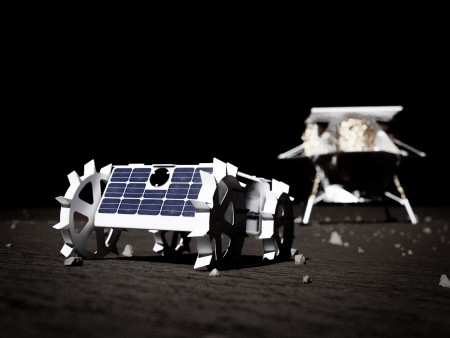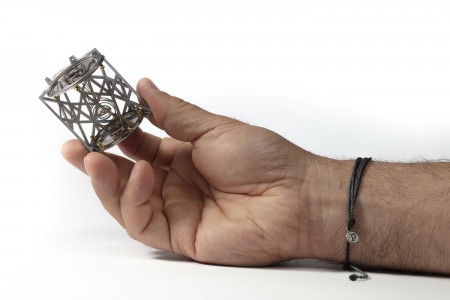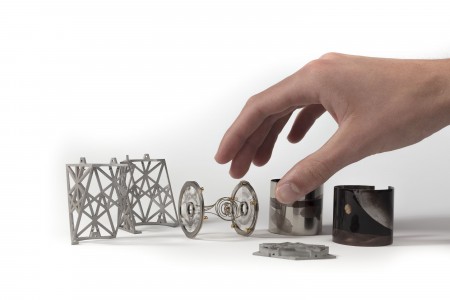CMU Becomes Space-Faring University With Payloads Aboard Astrobotic Lander

PITTSBURGH—Carnegie Mellon University is going to the moon, sending a robotic rover and an intricately designed arts package that will land in July 2021.
The four-wheeled robot is being developed by a CMU team led by William “Red” Whittaker, professor in the Robotics Institute. Equipped with video cameras, it will be one of the first American rovers to explore the moon’s surface. Although NASA landed the first humans on the moon almost 50 years ago, the U.S. space agency has never launched a robotic lunar rover.
The arts package, called MoonArk, is the creation of Lowry Burgess, space artist and professor emeritus in the CMU School of Art. The eight-ounce MoonArk has four elaborate chambers that contain hundreds of images, poems, music, nano-objects, mechanisms and earthly samples intertwined through complex narratives that blur the boundaries between worlds seen and unseen.
“Carnegie Mellon is one of the world’s leaders in robotics. It’s natural that our university would expand its technological footprint to another world,” said J. Michael McQuade, CMU’s vice president of research. “We are excited to expand our knowledge of the moon and develop lunar technology that will assist NASA in its goal of landing astronauts on the lunar surface by 2024.”
Both payloads will be delivered to the moon by a Peregrine lander, built and operated by Astrobotic Inc., a CMU spinoff company in Pittsburgh. NASA last week awarded a $79.5 million contract to Astrobotic to deliver 14 scientific payloads to the lunar surface, making the July 2021 mission possible. CMU independently negotiated with Astrobotic to hitch a ride on the lander’s first mission.
 “CMU robots have been on land, on the sea, in the air, underwater and underground,” said Whittaker, Fredkin University Research Professor and director of the Field Robotics Center. “The next frontier is the high frontier.”
“CMU robots have been on land, on the sea, in the air, underwater and underground,” said Whittaker, Fredkin University Research Professor and director of the Field Robotics Center. “The next frontier is the high frontier.”
For more than 30 years at the Robotics Institute, Whittaker has led the creation of a series of robots that developed technologies intended for planetary rovers — robots with names such as Ambler, Nomad, Scarab and Andy. And CMU software has helped NASA’s Mars rovers navigate on their own.
“We’re more than techies — we’re scholars of the moon,” Whittaker said.
The CMU robot headed to the moon is modest in size and form; Whittaker calls it “a shoebox with wheels.” It weighs only a little more than four pounds, but it carries large ambitions. Whittaker sees it as the first of a new family of robots that will make planetary robotics affordable for universities and other private entities.
The Soviet Union put large rovers on the moon fifty years ago, and China has a robot on the far side of the moon now, but these were massive programs affordable only by huge nations. The concept of CMU’s rover is similar to that of CubeSats. These small, inexpensive satellites revolutionized missions to Earth’s orbit two decades ago, enabling even small research groups to launch experiments.
Miniaturization is a big factor in affordability, Whittaker said. Whereas the Soviet robots each weighed as much as a buffalo and China’s rover is the weight of a panda bear, CMU’s rover weighs half as much as a house cat.
The Astrobotic landing will be on the near side of the moon in the vicinity of Lacus Mortis, or Lake of Death, which features a large pit the size of Pittsburgh’s Heinz Field that is of considerable scientific interest. The rover will serve largely as a mobile video platform, providing the first ground-level imagery of the site.
 The MoonArk has been assembled by an international team of professionals within the arts, humanities, science and technology communities. Mark Baskinger, associate professor in the CMU School of Design, is co-leading the initiative with Lowry.
The MoonArk has been assembled by an international team of professionals within the arts, humanities, science and technology communities. Mark Baskinger, associate professor in the CMU School of Design, is co-leading the initiative with Lowry.
The MoonArk team includes CMU students, faculty and alumni who worked with external artists and professionals involved with emerging media, new and ancient technologies, and hybrid processes. The team members hold degrees and faculty appointments in design, engineering, architecture, chemistry, poetry, music composition and visual art, among others. Their efforts have been coordinated by the Frank-Ratchye STUDIO for Creative Inquiry in CMU’s College of Fine Arts.
Baskinger calls the ark and its contents a capsule of life on earth, meant to help illustrate a vital part of the human existence: the arts.
“If this is the next step in space exploration, let’s put that exploration into the public consciousness,” he said. “Why not get people to look up and think about our spot in the universe, and think about where we are in the greater scheme of things?”
Contact: Byron Spice
412-268-9068
Pam Wigley
412-268-1047